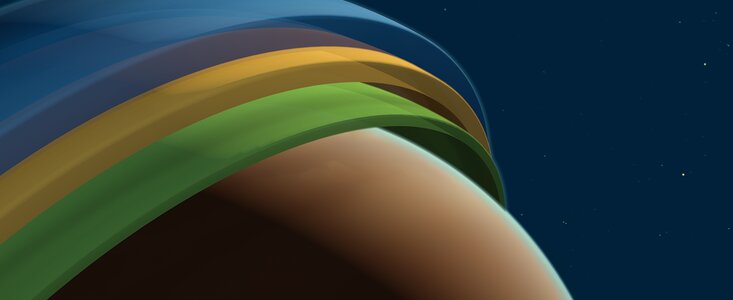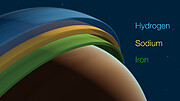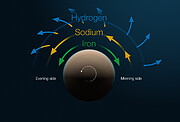Persbericht
Net sciencefiction: eerste 3D-waarnemingen van atmosfeer exoplaneet brengen uniek klimaat aan het licht
18 februari 2025
Astronomen hebben door de atmosfeer van een planeet buiten het zonnestelsel heen gekeken, en voor het eerst diens 3D-structuur in kaart gebracht. Door alle vier de 8,2-meter telescopen van de Very Large Telescope (VLT) van de Europese Zuidelijke Sterrenwacht (ESO) met elkaar te combineren, ontdekten ze sterke winden die chemische elementen zoals ijzer en titanium met zich mee voeren. Zo ontstaan complexe weerpatronen in de atmosfeer van de planeet. De ontdekking maakt gedetailleerde studies mogelijk van de chemische samenstelling en het weer op andere exoplaneten.
‘De atmosfeer van deze planeet gedraagt zich op manieren die onze kennis van de werking van het weer – niet alleen op aarde, maar op alle planeten – ter discussie stelt. Het voelt als sciencefiction,’ zegt Julia Victoria Seidel, onderzoeker bij de Europese Zuidelijke Sterrenwacht in Chili en hoofdauteur van het onderzoek waarvan de resultaten vandaag in Nature zijn gepubliceerd.
De betreffende planeet, WASP-121b (ook bekend als Tylos), staat op ongeveer negenhonderd lichtjaar in de richting van het zuidelijke sterrenbeeld Puppis (Achtersteven). Het is een ultrahete Jupiter – een gasplaneet die op zo’n kleine afstand om zijn moederster draait, dat een jaar daar slechts dertig aardse uren duurt. Bovendien is de ene kant van de planeet ziedend heet, omdat deze altijd naar de ster toe is gericht, terwijl de andere kant veel koeler is.
Het team heeft nu diep in de atmosfeer van Tylos gekeken en ontdekt dat de winden op verschillende diepten van elkaar verschillen. Aan de hand daarvan kon de 3D-structuur van de atmosfeer in kaart worden gebracht. Het is voor het eerst dat astronomen de atmosfeer van een planeet buiten ons zonnestelsel zo grondig en gedetailleerd hebben kunnen onderzoeken.
‘Wat we hebben ontdekt was verrassend: een straalstroom die materiaal rond de evenaar van de planeet laat draaien, terwijl een afzonderlijke stroming op lagere niveaus in de atmosfeer gas van de hete naar de koelere kant van de planeet verplaatst. Een klimaat als dit is nog nooit eerder op een planeet gezien,’ zegt Seidel, die tevens onderzoeker is bij het Lagrange-laboratorium van het Observatoire de la Côte d'Azur in Frankrijk. De snel bewegende straalstroom beslaat de helft van de planeet en brengt de hoger gelegen atmosfeer heftig in beroering terwijl deze het hete halfrond van Tylos passeert. ‘Daarmee vergeleken zijn zelfs de hevigste orkanen in ons zonnestelsel nogal mak’, voegt ze daaraan toe.
Om de 3D-structuur van de atmosfeer van de exoplaneet te onthullen, heeft het team gebruikgemaakt van het ESPRESSO-instrument van ESO’s VLT. Daarmee is het licht van zijn vier grote telescopen samengevoegd tot één signaal. In deze ‘gecombineerde modus’ verzamelt de VLT vier keer zoveel licht als elk van de telescopen afzonderlijk, waardoor zwakkere details te zien zijn. Door de planeet gedurende één volledige passage voor zijn ster waar te nemen, was ESPRESSO in staat om de signaturen van diverse chemische elementen te detecteren, en op die manier verschillende lagen van de planeetatmosfeer te bestuderen.
‘Met de VLT konden we in één klap drie verschillende lagen van de atmosfeer van de exoplaneet onderzoeken’, zegt medeauteur van de studie Leonardo A. dos Santos, assistent-astronoom bij het Space Telescope Science Institute in Baltimore, VS. Het team volgde de bewegingen van ijzer, natrium en waterstof, waardoor ze respectievelijk de winden in de diepe, middelste en onderste lagen van de atmosfeer van de planeet konden volgen. ‘Dit soort waarnemingen laat zich erg moeilijk uitvoeren met ruimtetelescopen, wat onderstreept hoe belangrijk exoplaneet-waarnemingen vanaf de grond zijn’, voegt hij daaraan toe.
Interessant genoeg lieten de waarnemingen ook zien dat er net onder de straalstroom titanium aanwezig was, zoals wordt bevestigd door een begeleidende studie die in Astronomy and Astrophysics is gepubliceerd. Dit kwam als een verrassing, omdat dit element bij eerdere waarnemingen van de planeet afwezig leek te zijn, mogelijk omdat het diep in de atmosfeer verscholen zit.
‘Het is werkelijk verbluffend dat we in staat zijn om details als de chemische samenstelling en weerpatronen van een planeet vanaf zo’n’grote afstand te bestuderen’, zegt Bibiana Prinoth, PhD-student bij de Universiteit van Lund (Zweden) en ESO, die leiding gaf aan de begeleidende studie en medeauteur is van het artikel in Nature.
Om ook de atmosferen van kleinere, aardachtige planeten te kunnen onderzoeken, hebben astronomen grotere telescopen nodig, zoals de Extremely Large Telescope (ELT) van ESO, die momenteel in aanbouw is in de Atacamawoestijn in Chili. ‘De ELT zal een grote impact hebben op het onderzoek van de atmosferen van exoplaneten’, zegt Prinoth. ‘Deze ervaring geeft me het gevoel dat we op het punt staan om ongelooflijke ontdekkingen te doen, waar we nu alleen nog maar van kunnen dromen.’
Meer informatie
De resultaten van dit onderzoek zijn te vinden in het artikel ‘Vertical structure of an exoplanet’s atmospheric jet stream’, dat in het tijdschrift Nature is gepubliceerd (doi:10.1038/s41586-025-08664-1).
Het onderzoeksteam bestaat uit: Julia V. Seidel (Europese Zuidelijke Sterrenwacht, Santiago, Chili [ESO Chile]; Laboratoire Lagrange, Observatoire de la Côte d’Azur, CNRS, Université Côte d’Azur, Nice, Frankrijk [Lagrange]), Bibiana Prinoth (ESO Chile en Lund Observatory, Division of Astrophysics, Department of Physics, Lund University, Lund, Zweden [ULund]), Lorenzo Pino (INAF-Osservatorio Astrofisico di Arcetri, Florence, Italië), Leonardo A. dos Santos (Space Telescope Science Institute, Baltimore, VS, Johns Hopkins University, Baltimore, VS), Hritam Chakraborty (Observatoire de Genève, Département d’Astronomie, Université de Genève, Versoix, Zwitserland [UNIGE]), Vivien Parmentier (Lagrange), Elyar Sedaghati (ESO Chile), Joost P. Wardenier (Département de Physique, Trottier Institute for Research on Exoplanets [IREx], Université de Montréal, Canada), Casper Farret Jentink (UNIGE), Maria Rosa Zapatero Osorio (Centro de Astrobiología, CSIC-INTA, Madrid, Spanje), Romain Allart (IREx), David Ehrenreich (UNIGE), Monika Lendl (UNIGE), Giulia Roccetti (Europese Zuidelijke Sterrenwacht, Garching bei München, Duitsland; Meteorologisches Institut, Ludwig-Maximilians-Universität München, München, Duitsland), Yuri Damasceno (Instituto de Astrofísica e Ciências do Espaço, Universidade do Porto, Porto, Portugal [IA-CAUP], Departamento de Fisica e Astronomia, Faculdade de Ciências, Universidade do Porto, Porto, Portugal [FCUP]; ESO Chile), Vincent Bourrier (UNIGE), Jorge Lillo-Box (Centro de Astrobiología (CAB); CSIC-INTA, Madrid, Spain), H. Jens Hoeijmakers (ULund), Enric Pallé (Instituto de Astrofísica de Canarias, La Laguna, Tenerife, Spanje [IAC]; Departamento de Astrofísica, Universidad de La Laguna, La Laguna, Tenerife, Spanje [IAC-ULL]), Nuno Santos (IA-CAUP en FCUP), Alejandro Suàrez Mascareño (IAC en IAC-ULL), Sergio G. Sousa (IA-CAUP), Hugo M. Tabernero (Departamento de Física de la Tierra y Astrofísica & IPARCOS-UCM (Instituto de Física de Partículas y del Cosmos de la UCM), Universidad Complutense de Madrid, Spanje), en Francesco A. Pepe (UNIGE).
Het begeleidende onderzoek, dat de aanwezigheid van titanium heeft aangetoond, is te vinden in het artikel ‘Titanium chemistry of WASP-121 b with ESPRESSO in 4-UT mode’ (doi: 10.1051/0004-6361/202452405)
The team achter dit artikelen bestaat uit: Bibiana Prinoth (Europese Zuidelijke Sterrenwacht, Santiago, Chili [ESO Chile] en Lund Observatory, Division of Astrophysics, Department of Physics, Lund University, Lund, Zweden [ULund]), Julia V. Seidel (ESO Chile; Laboratoire Lagrange, Observatoire de la Côte d’Azur, CNRS, Université Côte d’Azur, Nice, Frankrijk [Lagrange]), H. Jens Hoeijmakers (ULund), Brett M. Morris (Space Telescope Science Institute, Baltimore, VS), Martina Baratella (ESO Chile), Nicholas W. Borsato (ULund, School of Mathematical and Physical Sciences, Macquarie University, Sydney, Australië), Yuri Damasceno (Instituto de Astrofísica e Ciências do Espaço, Universidade do Porto, Porto, Portugal [IA-CAUP], Departamento de Fisica e Astronomia, Faculdade de Ciências, Universidade do Porto, Porto, Portugal [FCUP]; ESO Chile), Vivien Parmentier (Lagrange), Daniel Kitzmann (University of Bern, Physics Institute, Division of Space Research & Planetary Sciences, Bern, Zwitserland), Elyar Sedaghati (ESO Chile), Lorenzo Pino (INAF-Osservatorio Astrofisico di Arcetri, Florence, Italië), Francesco Borsa (INAF-Osservatorio Astronomico di Brera, Merate, Italië), Romain Allart (Département de Physique, Trottier Institute for Research on Exoplanets [IREx], Université de Montréal, Canada), Nuno Santos (IA-CAUP en FCUP), Michal Steiner (Observatoire de l'Université de Genève, Versoix, Zwitserland), Alejandro Suàrez Mascareño (Instituto de Astrofísica de Canarias, La Laguna, Tenerife, Spanje; Departamento de Astrofísica, Universidad de La Laguna, La Laguna, Tenerife, Spanje), Hugo M. Tabernero (Departamento de Física de la Tierra y Astrofísica & IPARCOS-UCM (Instituto de Física de Partículas y del Cosmos de la UCM), Universidad Complutense de Madrid, Spain) en Maria Rosa Zapatero Osorio (Centro de Astrobiologia, CSIC-INTA, Madrid, Spanje).
De Europese Zuidelijke Sterrenwacht (ESO) stelt wetenschappers van over de hele wereld in staat om de geheimen van het heelal te ontdekken, ten bate van iedereen. Wij ontwerpen, bouwen en exploiteren observatoria van wereldklasse die door astronomen worden gebruikt om spannende vragen te beantwoorden en de fascinatie voor astronomie te verspreiden, en bevorderen internationale samenwerking op het gebied van de astronomie. ESO, in 1962 opgericht als intergouvernementele organisatie, wordt inmiddels gedragen door 16 lidstaten (België, Denemarken, Duitsland, Finland, Frankrijk, Ierland, Italië, Nederland, Oostenrijk, Polen, Portugal, Spanje, Tsjechië, het Verenigd Koninkrijk, Zweden en Zwitserland) en door het gastland Chili, met Australië als strategische partner. Het hoofdkwartier van de ESO en haar bezoekerscentrum en planetarium, de ESO Supernova, zijn gevestigd nabij München in Duitsland, maar onze telescopen staan opgesteld in de Chileense Atacama-woestijn – een prachtige plek met unieke omstandigheden voor het doen van hemelwaarnemingen. ESO exploiteert drie waarnemingslocaties: La Silla, Paranal en Chajnantor. Op Paranal staan ESO’s Very Large Telescope en Very Large Telescope Interferometer, evenals surveytelescopen zoals VISTA. Ook zal ESO op Paranal de Cherenkov Telescope Array South huisvesten en exploiteren – ’s werelds grootste en gevoeligste observatorium van gammastraling. Samen met internationale partners beheert ESO APEX en ALMA op Chajnantor, twee faciliteiten die de hemel waarnemen in het millimeter- en submillimetergebied. Op Cerro Armazones, nabij Paranal, bouwen wij ‘het grootste oog ter wereld’ – ESO’s Extremely Large Telescope. Vanuit onze kantoren in Santiago, Chili, ondersteunen wij onze activiteiten in het gastland en werken wij samen met Chileense partners en de Chileense samenleving.
Links
- Onderzoeksartikel (Nature)
- Onderzoeksartikel (A&A)
- Foto’s van de VLT
- Kom meer te weten over ESO’s Extremely Large Telescope op onze speciale website en in de persmap
- Voor journalisten: abonneer je op onze persberichten onder embargo in je eigen taal en dien een aanvraag in om deel te nemen aan het (deels gesubsidieerde) Strategic Media Visits and Media Funding Scheme (NIEUW)
- Voor wetenschappers: heb je een verhaal? Promoot je onderzoek
- Donkerste en helderste lucht ter wereld in gevaar door industrieel megaproject
Contact
Julia Victoria Seidel
European Southern Observatory (ESO) and Lagrange Laboratory, Observatoire de la Côte d'Azur
Santiago, Chile and Nice, France
Tel: +33 743 32 79 73
E-mail: jseidel@oca.eu
Bibiana Prinoth
Lund University
Lund, Sweden
Tel: +46 72 442 03 69
E-mail: bibiana.prinoth@fysik.lu.se
Leonardo A. dos Santos
Space Telescope Science Institute
Baltimore, USA
Tel: +1 (410) 338-4395
E-mail: ldsantos@stsci.edu
Bárbara Ferreira
ESO Media Manager
Garching bei München, Germany
Tel: +49 89 3200 6670
Mobiel: +49 151 241 664 00
E-mail: press@eso.org
Marieke Baan (Perscontact Nederland)
ESO Science Outreach Network
en NOVA Informatie Centrum
Tel: +31(0)20-5257480
E-mail: eson-netherlands@eso.org
Over dit bericht
| Persberichten nr.: | eso2504nl |
| Naam: | WASP-121b |
| Type: | Milky Way : Star : Circumstellar Material : Planetary System |
| Facility: | Very Large Telescope |
| Instruments: | ESPRESSO |
| Science data: | 2025Natur.639..902S |
Our use of Cookies
We use cookies that are essential for accessing our websites and using our services. We also use cookies to analyse, measure and improve our websites’ performance, to enable content sharing via social media and to display media content hosted on third-party platforms.
ESO Cookies Policy
The European Organisation for Astronomical Research in the Southern Hemisphere (ESO) is the pre-eminent intergovernmental science and technology organisation in astronomy. It carries out an ambitious programme focused on the design, construction and operation of powerful ground-based observing facilities for astronomy.
This Cookies Policy is intended to provide clarity by outlining the cookies used on the ESO public websites, their functions, the options you have for controlling them, and the ways you can contact us for additional details.
What are cookies?
Cookies are small pieces of data stored on your device by websites you visit. They serve various purposes, such as remembering login credentials and preferences and enhance your browsing experience.
Categories of cookies we use
Essential cookies (always active): These cookies are strictly necessary for the proper functioning of our website. Without these cookies, the website cannot operate correctly, and certain services, such as logging in or accessing secure areas, may not be available; because they are essential for the website’s operation, they cannot be disabled.
Functional Cookies: These cookies enhance your browsing experience by enabling additional features and personalization, such as remembering your preferences and settings. While not strictly necessary for the website to function, they improve usability and convenience; these cookies are only placed if you provide your consent.
Analytics cookies: These cookies collect information about how visitors interact with our website, such as which pages are visited most often and how users navigate the site. This data helps us improve website performance, optimize content, and enhance the user experience; these cookies are only placed if you provide your consent. We use the following analytics cookies.
Matomo Cookies:
This website uses Matomo (formerly Piwik), an open source software which enables the statistical analysis of website visits. Matomo uses cookies (text files) which are saved on your computer and which allow us to analyze how you use our website. The website user information generated by the cookies will only be saved on the servers of our IT Department. We use this information to analyze www.eso.org visits and to prepare reports on website activities. These data will not be disclosed to third parties.
On behalf of ESO, Matomo will use this information for the purpose of evaluating your use of the website, compiling reports on website activity and providing other services relating to website activity and internet usage.
Matomo cookies settings:
Additional Third-party cookies on ESO websites: some of our pages display content from external providers, e.g. YouTube.
Such third-party services are outside of ESO control and may, at any time, change their terms of service, use of cookies, etc.
YouTube: Some videos on the ESO website are embedded from ESO’s official YouTube channel. We have enabled YouTube’s privacy-enhanced mode, meaning that no cookies are set unless the user actively clicks on the video to play it. Additionally, in this mode, YouTube does not store any personally identifiable cookie data for embedded video playbacks. For more details, please refer to YouTube’s embedding videos information page.
Cookies can also be classified based on the following elements.
Regarding the domain, there are:
- First-party cookies, set by the website you are currently visiting. They are stored by the same domain that you are browsing and are used to enhance your experience on that site;
- Third-party cookies, set by a domain other than the one you are currently visiting.
As for their duration, cookies can be:
- Browser-session cookies, which are deleted when the user closes the browser;
- Stored cookies, which stay on the user's device for a predetermined period of time.
How to manage cookies
Cookie settings: You can modify your cookie choices for the ESO webpages at any time by clicking on the link Cookie settings at the bottom of any page.
In your browser: If you wish to delete cookies or instruct your browser to delete or block cookies by default, please visit the help pages of your browser:
Please be aware that if you delete or decline cookies, certain functionalities of our website may be not be available and your browsing experience may be affected.
You can set most browsers to prevent any cookies being placed on your device, but you may then have to manually adjust some preferences every time you visit a site/page. And some services and functionalities may not work properly at all (e.g. profile logging-in, shop check out).
Updates to the ESO Cookies Policy
The ESO Cookies Policy may be subject to future updates, which will be made available on this page.
Additional information
For any queries related to cookies, please contact: pdprATesoDOTorg.
As ESO public webpages are managed by our Department of Communication, your questions will be dealt with the support of the said Department.





